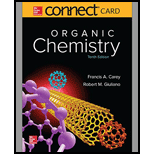
Concept explainers
Interpretation:
The preparations of given compounds by the appropriate
Concept introduction:
A molecule that consists of a
These
Retrosynthesis is used to identify the reactants. It involves the breaking of the target molecule into starting materials.
Want to see the full answer?
Check out a sample textbook solution
Chapter 21 Solutions
Connect Access Card Two Year for Organic Chemistry
- (−)-Hyoscyamine, an optically active drug used to treat gastrointestinal disorders, is isolated from Atropa belladonna, the deadly nightshade plant, by a basic aqueous extraction procedure. If too much base is used during isolation, optically inactive material is isolated. (a) Explain this result by drawing a stepwise mechanism. (b) Explain why littorine, an isomer isolated from the tailflower plant in Australia, can be obtained optically pure regardless of the amount of base used during isolation.arrow_forwardBupropion, sold under the trade name of Zyban, is an antidepressant that was approved to aid smoking cessation in 1997. Devise a synthesis of bupropion from benzene, organic compounds that have fewer than five carbons, and any required inorganic reagents.arrow_forwardDevise a synthesis of benzocaine, ethyl p-aminobenzoate(H2NC6H4CO2CH2CH3), from benzene, organic alcohols, and any neededorganic or inorganic reagents. Benzocaine is the active ingredient in thetopical anesthetic Orajelarrow_forward
- Bupropion, sold under the trade name of Zyban, is an antidepressant that was approved to aid smoking cessation in 1997. Devise a synthesis of bupropion from benzene, organic compounds that have fewer than ve carbons, and any required inorganic reagents.arrow_forwardDevise a synthesis of anastrozole, a drug used to reduce the recurrence of breast cancer (Section 22.18), from the given compounds. You may use any other needed organic compounds or inorganic reagents.arrow_forwardAttenol A and pinnatoxin A are natural products isolated from marine sources. (a) Locate the acetals, hemiacetals, imines, and enamines in both compounds. (b) Draw the hydrolysis product formed when attenol A is treated with aqueous acid. Include stereochemistry at all stereogenic centers.arrow_forward
- Devise a synthesis of muscalure, the sex pheromone of the common housefly, from acetylene and any other required reagents.arrow_forward(−)-Hyoscyamine, an optically active drug used to treat gastrointestinal disorders, is isolated from Atropa belladonna, the deadly nightshade plant, by a basic aqueous extraction procedure. If too much base is used during isolation, optically inactive material is isolated. (a) Explain this result by drawing a stepwise mechanism. (b) Explain why littorine, an isomerisolated from the tailower plant in Australia, can be obtained optically pure regardless of the amount of base used during isolation.arrow_forwardDevise a stepwise mechanism for the following reaction, a key step in the synthesis of the antibiotic abyssomicin C. Abyssomicin C was isolated from sediment collected from almost 1000 ft below the surface in the Sea of Japan.arrow_forward
- The analgesic naproxen can be prepared by a stepwise reaction sequence from ester A. Using enolate alkylation in one step, what reagents are needed to convert A to naproxen? Write the structure of each intermediate. Explain why a racemic product is formed.arrow_forwardWhat product is formed when A is treated with Grubbs catalyst underhigh-dilution conditions? This reaction was a key step in the synthesis ofstemoamide, the naturally occurring amide described in the opening paragraph.arrow_forward
 ChemistryChemistryISBN:9781305957404Author:Steven S. Zumdahl, Susan A. Zumdahl, Donald J. DeCostePublisher:Cengage Learning
ChemistryChemistryISBN:9781305957404Author:Steven S. Zumdahl, Susan A. Zumdahl, Donald J. DeCostePublisher:Cengage Learning ChemistryChemistryISBN:9781259911156Author:Raymond Chang Dr., Jason Overby ProfessorPublisher:McGraw-Hill Education
ChemistryChemistryISBN:9781259911156Author:Raymond Chang Dr., Jason Overby ProfessorPublisher:McGraw-Hill Education Principles of Instrumental AnalysisChemistryISBN:9781305577213Author:Douglas A. Skoog, F. James Holler, Stanley R. CrouchPublisher:Cengage Learning
Principles of Instrumental AnalysisChemistryISBN:9781305577213Author:Douglas A. Skoog, F. James Holler, Stanley R. CrouchPublisher:Cengage Learning Organic ChemistryChemistryISBN:9780078021558Author:Janice Gorzynski Smith Dr.Publisher:McGraw-Hill Education
Organic ChemistryChemistryISBN:9780078021558Author:Janice Gorzynski Smith Dr.Publisher:McGraw-Hill Education Chemistry: Principles and ReactionsChemistryISBN:9781305079373Author:William L. Masterton, Cecile N. HurleyPublisher:Cengage Learning
Chemistry: Principles and ReactionsChemistryISBN:9781305079373Author:William L. Masterton, Cecile N. HurleyPublisher:Cengage Learning Elementary Principles of Chemical Processes, Bind...ChemistryISBN:9781118431221Author:Richard M. Felder, Ronald W. Rousseau, Lisa G. BullardPublisher:WILEY
Elementary Principles of Chemical Processes, Bind...ChemistryISBN:9781118431221Author:Richard M. Felder, Ronald W. Rousseau, Lisa G. BullardPublisher:WILEY





